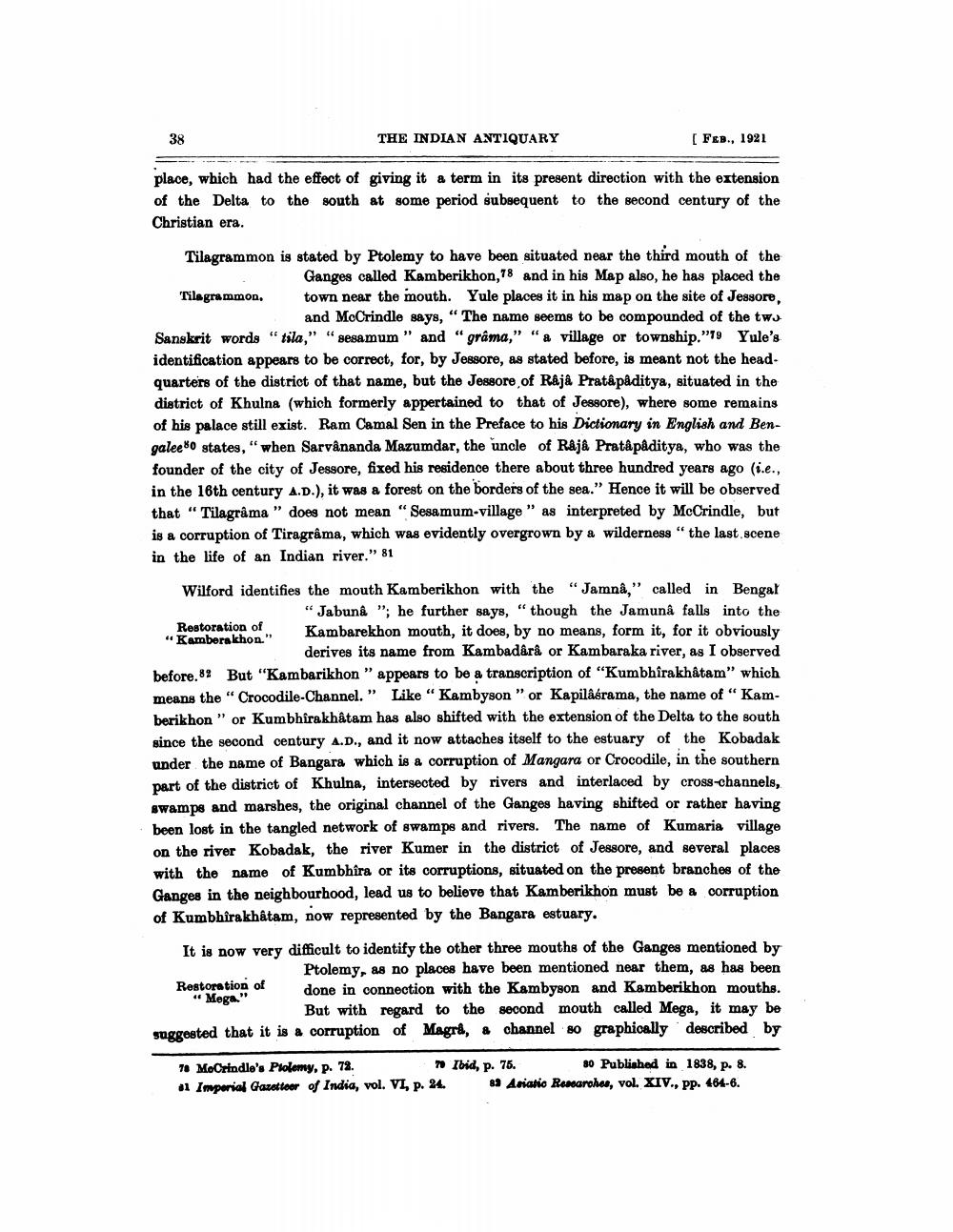________________
38
THE INDIAN ANTIQUARY
[F&B., 1921
place, which had the effect of giving it a term in its present direction with the extension of the Delta to the south at some period subsequent to the second century of the Christian era.
Tilagrammon is stated by Ptolemy to have been situated near the third mouth of the
Ganges called Kamberikhon,78 and in his Map also, he has placed the Tilegrammon. town near the mouth. Yule places it in his map on the site of Jessore,
and MoCrindle says, " The name seems to be compounded of the tws Sanskrit words " tila," "sesamum " and "grâma," "a village or township.”19 Yule's identification appears to be correct, for, by Jessore, as stated before, is meant not the head. quarters of the district of that name, but the Jessore of Raja Pratápaditya, situated in the district of Khulna (which formerly appertained to that of Jessore), where some remains of his palace still exist. Ram Camal Sen in the Preface to his Dictionary in English and Bengalee 80 states," when Sarvânanda Mazumdar, the uncle of Raj& Pratå påditya, who was the founder of the city of Jessore, fixed his residence there about three hundred years ago (i.e., in the 16th century A.D.), it was a forest on the borders of the sea." Hence it will be observed that "Tilagrâma" does not mean "Sesamum-village" as interpreted by McCrindle, but is a corruption of Tiragrâma, which was evidently overgrown by a wilderness "the last scene in the life of an Indian river." 81
Wilford identifies the mouth Kamberikhon with the “Jamna," called in Bengal
"Jabuna "; he further says, "though the Jamuna falls into the Restoration of "Kamberakhon."
Kambarekhon mouth, it does, by no means, form it, for it obviously
derives its name from Kambadârå or Kambaraka river, as I observed before.82 But "Kambarikhon " appears to be a transcription of "Kumbhirakhâtam" which means the "Crocodile-Channel." Like " Kambyson " or Kapilâśrama, the name of “Kamberikhon " or Kumbhîrakhâtam has also shifted with the extension of the Delta to the south since the second century A.D., and it now attaches itself to the estuary of the Kobadak under the name of Bangara which is a corruption of Mangara or Crocodile, in the southern part of the district of Khulna, intersected by rivers and interlaced by cross-channels, swamps and marshes, the original channel of the Ganges having shifted or rather having been lost in the tangled network of swamps and rivers. The name of Kumaria village on the river Kobadak, the river Kumer in the district of Jessore, and several places with the name of Kumbhîra or its corruptions, situated on the present branches of the Ganges in the neighbourhood, lead us to believe that Kamberikhon must be a corruption of Kumbhîrakhâtam, now represented by the Bangara estuary.
It is now very difficult to identify the other three mouths of the Ganges mentioned by
Ptolemy, as no places have been mentioned near them, as has been Restoration of done in connection with the Kambyson and Kamberikhon mouths. “ Mega."
But with regard to the second mouth called Mega, it may be suggested that it is a corruption of Magri, & channel 80 graphically described by
70 Morindle's Polomy, p. 78. #1 Imperial Gazetteer of India, vol. VI, p. 24.
Ibid, p. 76. 80 Published in 1838, p. 8.
Asiatic Reacarohae, vol. XIV., PP. 464-6.




